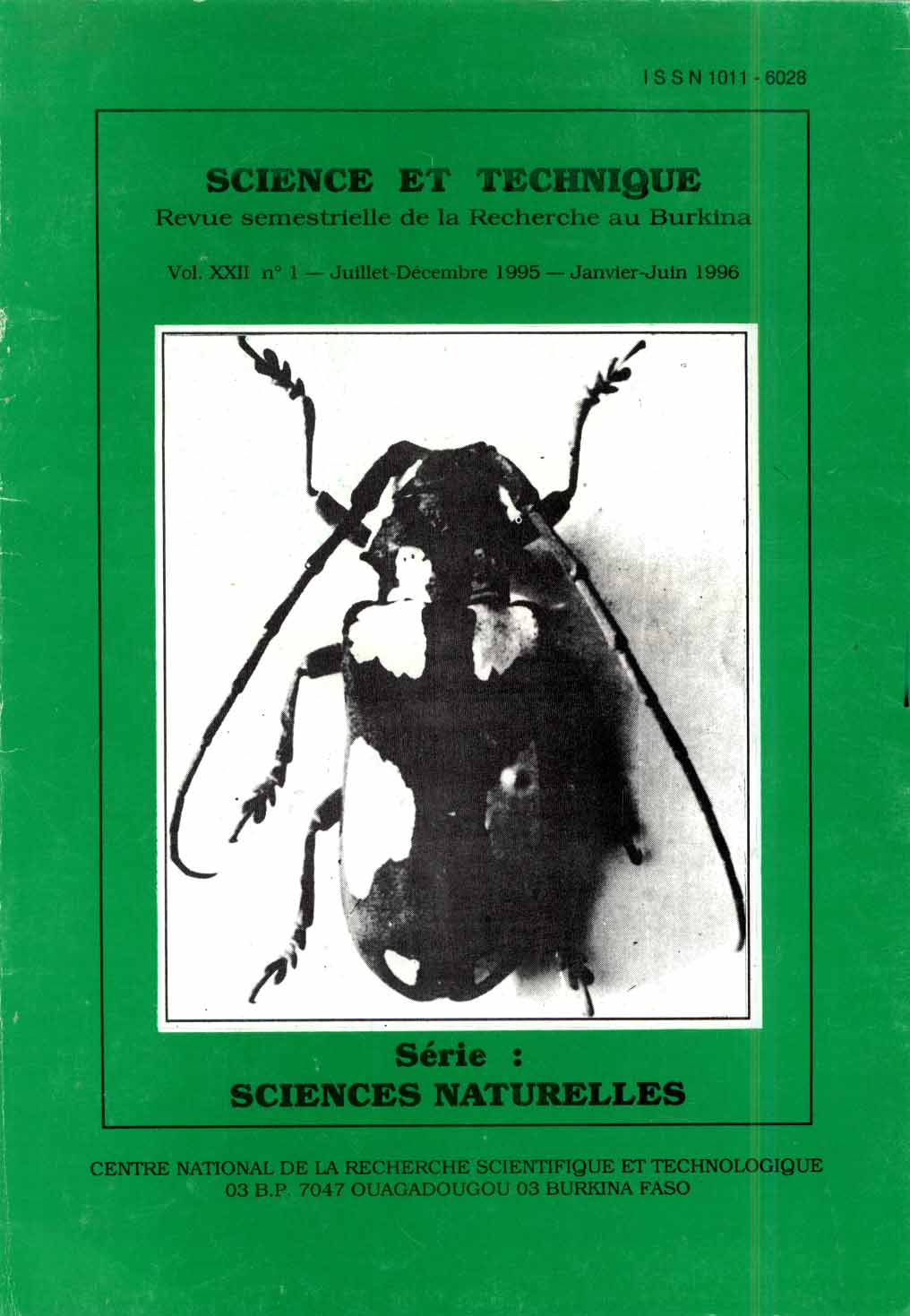A PROPOS DU NEEM AU BURKINA FASO NÉCESSITÉ D'UNE MAÎTRISE DE SON EXPANSION
THE NEEM IN BURKINA FASO NECESSITY OF THE CONTROL OF ITS EXPANSION
Mots-clés :
neem, introduction, dissémination, expansion, Burkina FasoRésumé
Français
Le neem (Azadirachta indica A. Juss.) est une plante ligneuse exotique subspontanée des régions soudano-sahéliennes. C'est une espèce très utilisée par les populations locales. Depuis une dizaine dannées, les peuplements de neem se développent à un rythme inquiétant et envahissent les terroirs. Les plants de neem poussent autour des pieds de nombreux autres ligneux (Acacia albida Del., Parkia biglobosa Benth., Butyrospennum paradoxum subsp parkii (G.I)on) Hepper, Adansonia digitata L, Ceiba pentandra O..) Gaertn. , Bombax cosfatum (Pell. et Vuil., etc.), occupent le sol sous le houppier et tend à les étouffer. Or certaines de ces plantes envahies comma ie zaanga (Acacia albida Del. syn. Faidherbia albidu (Del.) A. Chev.) fertilisent le sol par symbiose mycorhiziennne et augmentent les rendements agricoles de mil sous leur houppier. A partir d'observations de terrain, d'enquêtes et de données bibliographiques, nous voulons attirer l'attention de l'opinion scientifique sur la nature du phénomène et son rôle dans la gestion des terroirs au Burkina Faso. De part sa dynamique agressive, le neem risque de destabiliser l'équilibre écologique à Ion terme.
Anglais
The neem (Azadirachta indica A. Juss.) is an exotic and subspontaneous woody species of soudanosahelian region.It was introduced in Burkina Faso (ex Upper Volta ) in 1944 or thereabouts from Ghana. That is why it is called by ghanaian language, ashanti and cobru in neighbouring provinces : "Ponguda" in Bulgu province and Tiafye in Sissili province. In the sahelian provinces of Yagha, Seno and üdalan, its name is "Tirutia" in fulani "means the bitter tree which can be planted" and "Melia" in zerma.
An sixty years old man of Kadiogo province told us that they managed to get young plants during the age of colonization. These plants disseminated their seeds by birds like purple glossey starlings (Lamprotomis caudatus (Müller)), long-tailed glossey starlings ((Lamprotornis purpuropferus (Müller)), commun garden bulbuls (Pycnonotus barbarus Desfontaines), grey plantain-eatars (Crinifer piscator (Boddaert)), West afiican trushes (Turdus pelios Bonaparte) and Doves (Streptopelia ssp.).
They developed fast during the 1st fifty years in Burkina Faso. Local populations use it as fuelwood and timber, food and medecjnes for both humain beeings and herds, and CO manage soi1 fertility etc.The neem grows better than the other growing plants on rocky, lateritic and shallow soils , It can even develop in salinic soils but can't :stand flood. its root system is both tap-rooted and creeping. The lateral roots are about 15 meters long and could be in competition with neigbouring plants. The neem plantation spreads out quickiy and disquietingly to invade lands. Neem grows around many other woody species like Acacia albida Del., Parkia biglobosa Benth., Butyrospermum paradoxum subsp parkii (G. Don) Hepper, Adansonia digitutcd L., Ceibu pentandra (L.) Gaertn. , Bomba costarum (Peil, et Vuii.).
It occupies the soil under the canopies and finally invades thern. And then these trees like Acacia albida are soi1 fertilizing and increase yield for the millet under the ground-projected area of their canopy. From few observations, investigations on twenty persons and bibliographic references, we try to attract public opinion on this phenomenen and its impact on land management in the country.
In Burkina Faso, it is necessary to control its expansion. But elsewhere like Chad Lake region (Niger, Chad, Nigeria) and Carnerun, the neem has died because of aridity, cochineals (Aonidiella onentulis and Insulapsis repleyi (Diuspididm family), Maconellicoccus hirsutus (Pseudicoccidae family), Aspidoproctus bifurcatus (Maryrodidae family)), virus and fungus. So, few questions should be asked and could constitute research activities :
- How to increase its use and how to contol its expansion in Burkina Faso? - What are its aerial foliage role in the soil fertility turn-over?
- Are there enough knownledge about its impact on the pedologic properties of the soils?
- What is the role of the root system organization in soi1 nutriments absorption and competition with,
- Have the neem trees been infected in Burkina Faso and what are the effects of accidental cutting crops? of the foliage along roads through countries by trucks?

